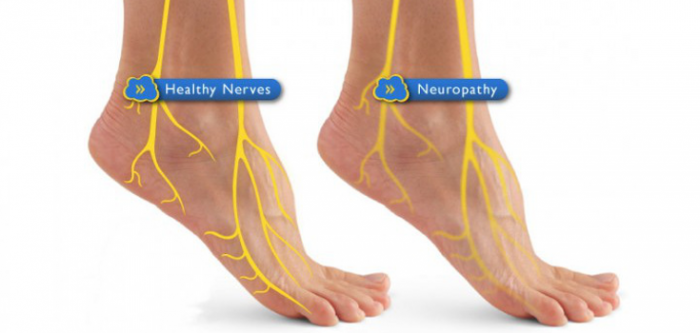Diabetes Foot Damage
Good foot care is very important to prevent serious infections and gangrene. although rare, nerve damage from diabetes can lead to changes in the shape of your feet, such as charcot’s foot. charcot’s foot may start with redness, warmth, and swelling. If nerve damage strikes your digestive tract, you can have constipation or diarrhea, or both. diabetes-related nerve damage can lead to gastroparesis, a condition in which the stomach empties too slowly or not at all, which causes bloating and indigestion. sexual dysfunction. autonomic neuropathy often damages the nerves that affect the sex organs. Diabetic neuropathy is damage of the nerves that’s caused by diabetes. scientists believe that the high content of blood sugar in the blood of a person with diabetes damages nerves over time.
Diabetic Charcot Foot Orthoinfo Aaos
Kidney disease. diabetes can damage the kidneys. kidney damage sends toxins into the blood, which can lead to nerve damage. being overweight. having a body mass index (bmi) of 25 or more may increase your risk of diabetic neuropathy. smoking. smoking narrows and hardens your arteries, reducing blood flow to your legs and feet. Most foot problems that people with diabetes face arise from two serious complications of the disease: nerve damage and poor circulation. one of the more critical foot problems these complications can cause is charcot arthropathy, which can deform the shape of the foot and lead to disability. Foot complications. people with diabetes can develop many different foot problems. even ordinary problems diabetes foot damage can get worse and lead to serious complications. foot problems most often happen when there is nerve damage, also called neuropathy. this can cause tingling, pain (burning or stinging), or weakness in the foot.
Can Diabetic Neuropathy Be Reversed
Diabetes And Foot Problems Niddk

Understanding diabetic nerve damage. manage your blood sugar to prevent diabetic neuropathy. about half of all people with diabetes have some form of nerve damage. that damage is called neuropathy and can be painful or result in loss of protection sensation. diabetic neuropathy is a serious and common problem of diabetes. Diabetic neuropathy can cause numbness or tingling in your fingers, toes, hands, and feet. another symptom is a burning, sharp, or aching pain (diabetic nerve pain). Diabetes can harm your nerves. that damage, called neuropathy, may be painful.. it can happen in several ways, and they all seem to be related to blood sugar levels being too high for too long. to. Circulation. foot problems in diabetes can be caused by damage to both large and small blood vessels, which is much more common in diabetes. foot problems, including nerve damage or peripheral neuropathy, usually begin with vascular disease.
Diabetes leads to high levels of glucose in the blood. without careful management, this can diabetes foot damage cause damage throughout the body. diabetic neuropathy is nerve damage that results from diabetes. no cost to you ? how does diabetes cause foot problems ? diabetes can cause neuropathy (nerve damage), which reduces feeling in your feet this makes you less likely to feel the early warning signs of foot problems decreased circulation reduces the ability to heal
Diabetic Foot Problems Symptoms Treatment And Care
How to spot diabetic foot complications early health24.
Nerve damage, along with poor blood flow—another diabetes complication—puts you at risk for developing a foot ulcer (a sore or wound) that could get infected and not heal well. if an infection doesn’t get better with treatment, your toe, foot, or part of your leg may need to be amputated (removed by surgery) to prevent the infection from. Nerve damage, along with poor blood flow—another diabetes complication—puts you at risk for developing a foot ulcer (a sore or wound) that could get infected and not heal well. if an infection doesn’t get better with treatment, your toe, foot, or part of your leg may need to be amputated (removed by surgery) to prevent the infection from. See more videos for diabetes foot damage. Diabetes can weaken the bones in your foot so much diabetes foot damage that they break. nerve damage can lessen sensation and prevent you from realizing it. you keep walking on broken bones and your foot will change.
If you have diabetes, you're at increased risk of various bone and joint disorders. certain factors, such as nerve damage (diabetic neuropathy), arterial disease and obesity, may contribute to these problems — but often the cause isn't clear. learn more about various bone and joint disorders, including symptoms and treatment options. A serious foot problem is when damage to your foot means it needs emergency attention. having diabetes means that you’re more at risk of serious foot problems, and these can lead to amputation. this is more likely to happen if you’ve been told your level of risk for getting foot problems is high. As we now know, neuropathy and peripheral vascular disease associated with diabetes affect the feet. one of the biggest risks for diabetics is foot ulcers which can eventually lead to amputation. Peripheral neuropathy can result from traumatic injuries, infections, metabolic problems, inherited causes and exposure to toxins. one of the most common causes is diabetes. people with peripheral neuropathy generally describe the pain as stabbing, burning or tingling. in many cases, symptoms improve, especially if caused by a treatable condition.
Having diabetes means you’re at much greater risk of developing foot problems. this is because raised blood glucose, also known as blood sugar, can damage the sensation in your feet. it can also affect your circulation, which can lead to you getting less blood supply to your feet. without a good blood supply you may have problems with cuts and sores healing. Over time, diabetes may cause nerve damage, also called diabetic neuropathy, that can cause tingling and pain, and can make you lose feeling in your feet. when you lose feeling in your feet, you may not feel a pebble inside your sock or a blister on your foot, which can lead to cuts and sores.


The general rule for people with diabetes is to notify your doctor if you notice any change in feeling or appearance in your feet. this page provides information on the range of symptoms that can indicate a wide variety of diabetic foot problems. foot problems can quickly become serious so it’s important to check your feet daily for signs of damage or change in addition to attending foot. given enough time and with enough severity of damage the body starts breaking down and eventually failing diabetes and the importance of diabetic foot wear for many diabetics the extremities and the Diabeticfoot and lower limb complications are severe and chronic. they affect 40 to 60 million people with diabetes globally. chronic ulcers and amputations result in a significant reduction in the quality of life and increase the risk of early death. less than one-third of physicians recognise the signs of diabetes-related peripheral neuropathy. Diabetes can cause nerve damage in the feet, which causes symptoms of diabetic foot problems. the damaged diabetes foot damage nerves can cause decreased sensation in the feet, which can lead to mild to severe problems and complications like bunions and corns, or gangrene and foot amputation.
Diabetes and foot problems symptoms (swelling), treatment.

Comments
Post a Comment